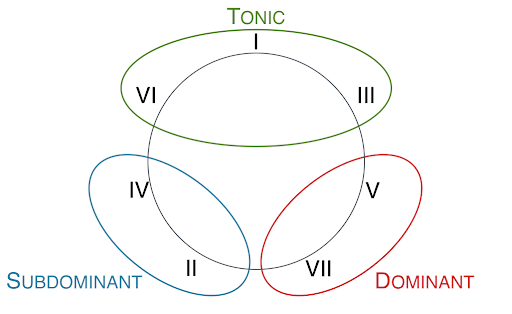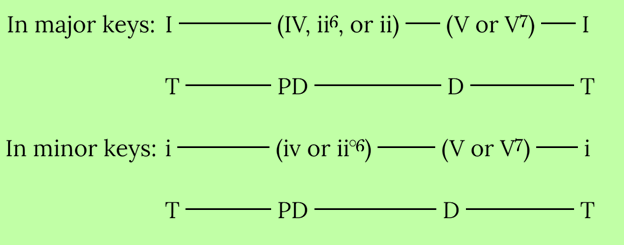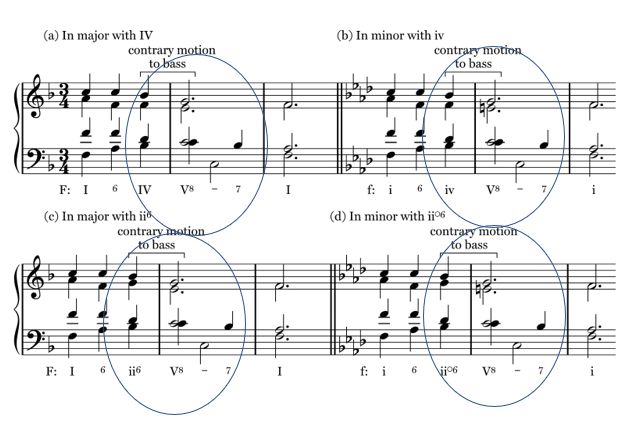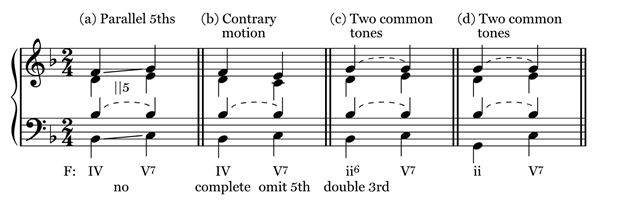Before we dive into the predominant world or even a phrase, let’s review
harmonic functions. Always remembering these can be either in a major or minor key.
Image from: http://openmusictheory.com/harmonicFunctions.html
Tonic: Chords I, VI, or III
Subdominant (or now pre-dominant): IV or ii
Dominant: V⁷ – vii0
In unit 4 we discussed how a dominant-tonic motion completes the basic phrase structure, and this is called a cadence. Now we are going to add an additional chord. This chord is going to have a predominant function because it will be placed BEFORE ⬅️the dominant. The pre-dominant chord is also commonly called a sub-dominant.
Pre-dominant harmonies (ii and IV) – and their minor keys equivalents- are so named because they LEAD to the dominant. That is now ii-V or IV-V. Think of it as a preparation of the dominant. Its function is to expand the basic phrase going from T-D-T to T- PD- D- T. This type is phrase is more used than T-D-T.
Harmonic flowchart for Major Keys. Chors IV or ii serve as a Pre-Dominant function. Image from Robert Hutchinson: http://musictheory.pugetsound.edu/mt21c/HarmonicFunction.html
Harmonic flowchart for minor keys. Chords iv or ii0 serve as pre-dominant function in minor keys. Image from Robert Hutchinson: http://musictheory.pugetsound.edu/mt21c/HarmonicFunction.html
Now that we know what the predominant chords are, we have more options or choices to create a new phrase, follow this template to construct your basic phrase- T- PD- D- T.
Basic phrase structure, Image from: The Muscicians Guide for Theory and Analysis. Third edition.
Considering the new options, you have with the predominant chords: What are some of the differences or choices that you have in Major Keys vs. Minor Keys? What remained the same?
Let’s review:
- Predominant appear BEFORE the dominant.
- Predominant options are:
- Major Keys- IV, ii6, or ii
How exactly did we get there? 🤔 That's right, BEFORE dominant! The voice leading on a predominant must follow contrary motion against the bass. This way, you avoid parallelism and other voice-leading errors.
Contrary motion with bass will help you avoid voice-leading errors when working with pre-dominant chords. Image from: The Muscicians Guide for Theory and Analysis. Third edition.
Predominant to V⁷:
As you are figuring out now, contrary motion will help us most of the time, however, there are still rules we need to double-check ✅ when writing ✍️harmonies. When a predominant chord moves to a V⁷, the chordal seventh (the seventh of the chord) needs to be prepared by a common tone. In order for that to happen, you must choose carefully which chord is appropriate while keeping in mind that a V⁷ chord has 4 notes. To avoid parallel 5ths, you must always go in contrary motion and keep common tones when possible. Here’s a nice view of what your options might look like:
a) Parralel 5ths between soprano and bass. b) Contrary motion agaist the bass. C) and d) Two common tones, always keep common tones when possible. This is always a good idea. Image from: The Muscicians Guide for Theory and Analysis. Third edition.








